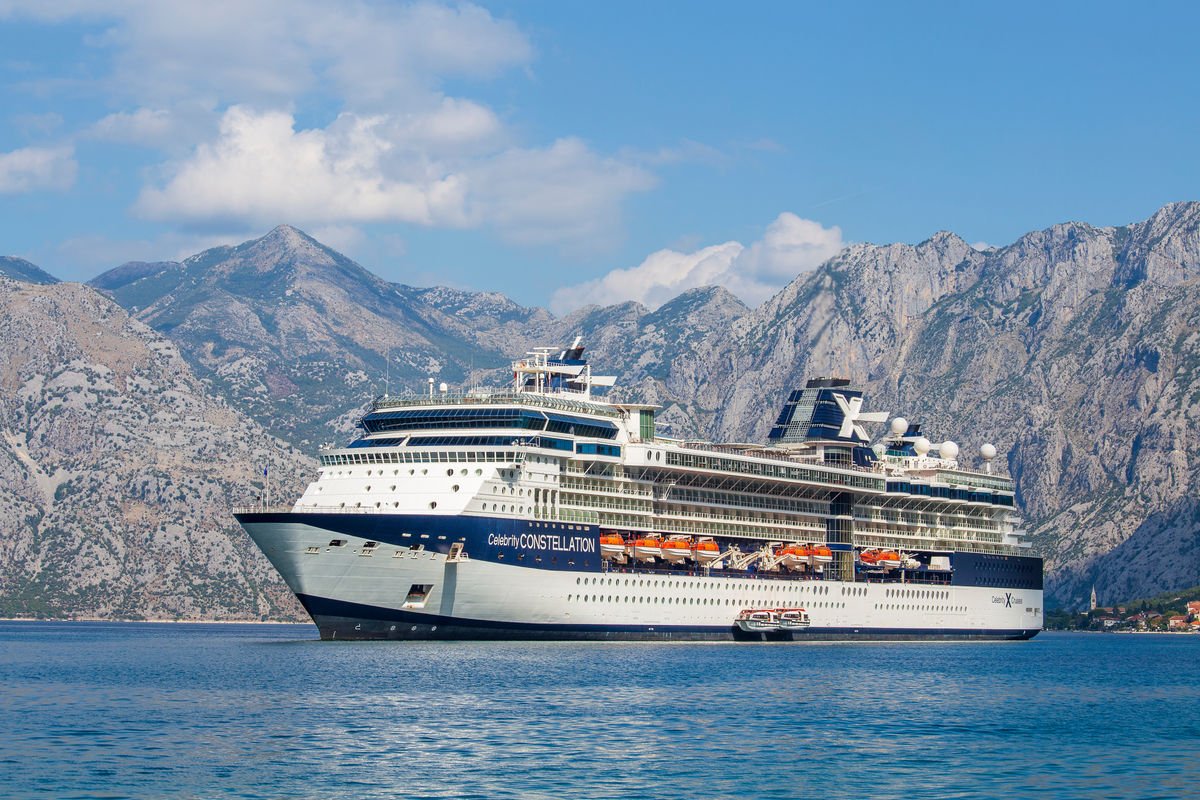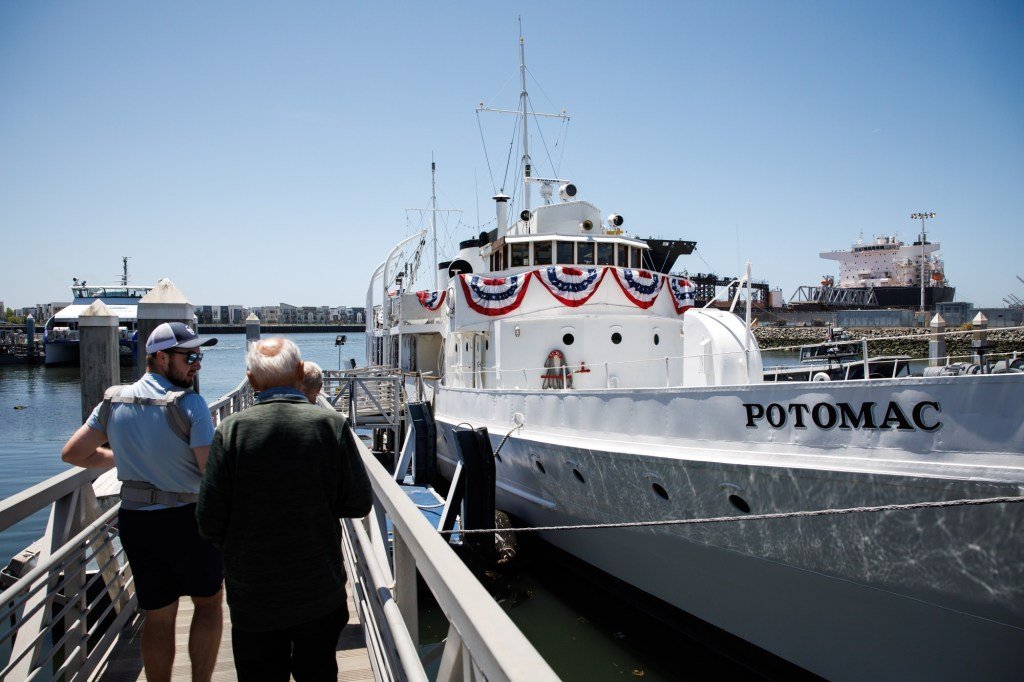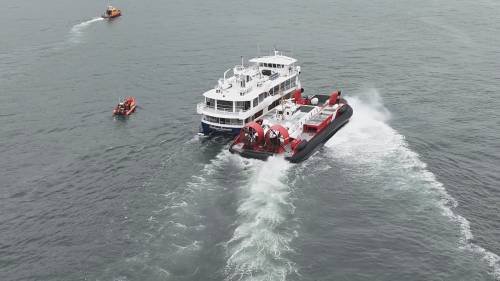Cruise & Ferry
Today in History – August 4: Captain of sinking cruise ship abandons 400 passengers – 9News

Cruise & Ferry
Harbour Cruises ship runs aground – Global News
Cruise & Ferry
Power Outage Leaves Cruise Ship Adrift Off Italian Coast

For roughly two
hours on Saturday, August 2, the Celebrity Constellation was without power and adrift
in the Ionian Sea about 25 miles southeast of Crotone, Italy. The vessel, which
was in the midst of an 11-night cruise from Ravenna to Rome, had been scheduled
for a sea day before its next stop in Messina, Sicily.
Although power was
partially restored after a couple of hours, the ship continued to drift for a
bit longer, moving at only one or two knots—far below its top cruising speed of
24 knots.
Passengers on board
the ship took to social media and cruise message boards to describe the
experience. According to several accounts, the ship temporarily had no
lighting, no air conditioning and non-functioning toilets. Guests were
reportedly served only cold meals for dinner during the outage.
“One hour in and it’s
HOT,” one guest wrote at the time, noting how quickly things became
uncomfortable inside the ship. With outside temperatures hovering around 80
degrees Fahrenheit, the lack of air conditioning, and therefore air circulation,
would have made interior areas very stuffy.
Some comparisons
were even drawn to the infamous so-called “poop cruise” that occurred aboard Carnival
Triumph in 2013, which was recently the subject of a Netflix documentary. However,
that incident involved a much more serious power outage, which lasted days and
led to an almost unlivable situation on board. Although Celebrity
Constellation’s issues were far shorter in duration and not as severe, the
disruption was still jarring for passengers.
According to Cruise
Hive’s report, Celebrity Cruises has not yet officially stated what
triggered the outage. Engine room fires and electrical problems are common
culprits in situations like these, though other mechanical failures can also
lead to a full loss of power.
Cruise ships like
the Celebrity Constellation are designed to handle emergencies and are equipped
with systems to communicate with both land-based authorities and the cruise
line’s headquarters. Engineering teams onboard would have responded quickly to
assess the situation and begin repairs to restore power and ensure the ship
could safely continue its journey.
The Celebrity
Constellation, one of Celebrity Cruises’ older ships, belonging to its Millennium
class, was first launched in 2002. The vessel weighs in at about 90,940 gross
tons and carries more than 2,100 guests along with 1,000 crew members.
As of now,
operations have resumed and Celebrity Constellation has continued
on its itinerary, although there has been no official word on whether the ship actually
arrived in Messina on August 3, as originally scheduled. However, tracking
website CruiseMapper shows the vessel currently en route to Naples, the next
stop on its itinerary.
For the latest travel news, updates and deals, subscribe to the daily TravelPulse newsletter.
Topics From This Article to Explore
Cruise & Ferry
The most unusual cruise ship in the Bay Area? It’s FDR’s yacht in Oakland

In the Bay Area, nice ships are a dime a dozen.
But there’s only one ship that was the presidential yacht for Franklin D. Roosevelt and owned by Elvis, then later impounded in one of the biggest drug busts in U.S. history, before sinking in 30 feet of water — and then improbably rising again as a National Historic Landmark.
It’s the USS Potomac, and it’s open for public tours in Oakland’s Jack London Square. Even locally, however, most people haven’t heard its story.
“She’s a relative secret, still,” says John Eichel, a volunteer docent for the nonprofit USS Potomac Association. “Many folks in Alameda, right across the water, don’t even know about it.”
On this particular day, Eichel is giving a tour to a small group who board the ship as the breeze kicks up and the temperature – hot and dry on land – drops several degrees. Pelicans soar drunkenly, and cormorants slip snakelike below the brackish estuary. There’s an inquisitive sea lion that sometimes visits, too, but he seems to be taking the day off.
Ivory-white and 165-feet long, the modified U.S. Coast Guard cutter casts a presidential aura despite a weld transecting its midriff like a nasty surgical scar, evidence of post-sinking renovations. In the 1940s and ’50s, she chugged around the Eastern seaboard and earned the nickname the “Floating White House.” Roosevelt did indeed use her for official purposes, like entertaining foreign heads of state such as King George VI and Queen Elizabeth, and conducting secret wartime meetings.
Partially disabled from polio (or perhaps Guillain–Barré syndrome, according to modern theories), the president had a smokestack converted into a hand-powered, rope-and-pulley elevator and a settee where he could put his feet up to enjoy his famously weird martinis.
The front end of the boat is where Roosevelt conducted business, and the back was the presidential or “party end,” says Eichel. “So it’s business in the front, party in the back,” quips a visitor.
The top speed used to be 20 knots, but now it scoots around at 11 knots. “Unless we have Captain Richard. He likes to push things a bit,” jokes Eichel. The same visitor pipes up again: “Sounds like he belongs on the party side of the boat.”
The Potomac offers tours between one and three hours long as well as dockside tours for landlubbers, which is what we’re doing today. It’s hired out for charters, does special cruises on military dates like Veterans Day and VJ Day and hosts wine tastings and music by blues and cover bands.
In November, the ship will host what Jennifer Pettley, executive director of the USS Potomac Association calls an “Elvis concert live on board.”
“We have an Elvis impersonator, one of the best in the Bay Area,” she says.
Right now, though, Eichel is pointing at a toilet. There were more than 50 crew members when FDR was in charge, including U.S. Navy and Secret Service personnel, and most had to share a single “head.” There were other inconveniences if you weren’t white. The sleeping bunks for Filipino crew members were located in the ship’s front, where waves hit hardest — one of the more outward signs of discrimination at the time.
Roosevelt hated flying and was a lifelong boat guy. He sailed the Hudson as a kid and went on to become assistant secretary of the Navy. He preferred his ships constructed of metal, like the Potomac, because he didn’t want to be trapped on a wooden one in a wheelchair while it was burning, according to Eichel.
“I think he found his greatest moments of relaxation and peace when he was on this boat or another boat,” says Tom Dana, a volunteer docent.
Some say Roosevelt used the Potomac to get away from the pressures of office. Others say it was to get away from Henrietta Nesbitt, the housekeeper who supervised the kitchen at the White House. Nesbitt’s motto was “plain foods, plainly prepared,” and the cuisine was so repetitive guests knew what they’d eat by what day it was: Monday was tongue with broccoli, Tuesday boiled beef with mixed greens.
“And so it happened that the most powerful man in the free world often spent his dinners eating only what he could bear,” reads a sign onboard the ship, “then rummaging up egg sandwiches in a little kitchen next to the presidential study.”
Roosevelt used the party end of the ship for his “Children’s Hour,” named after a Henry Wadsworth Longfellow poem, which was a time of hobnobbing with his inner circle and guests, where talk of politics and business was forbidden. With a Naval aid holding his arm, he’d hold court while mixing cocktails whose recipes were seemingly beamed down from Mars.
“The martinis started out simple enough, usually as a 3:1 or sometimes 4:1 gin and dry vermouth,” according to a 2021 article from a National Archives technician. “Shaken over ice. Cocktail glass. Olive or lemon peel garnish. Then it gets complicated…. Perhaps he might add some fruit juices or liqueurs or substitute with an alternative liquor for gin when his home bar was limited. Sometimes an extra measure of gin to be on the safe side, as he could lose track of his measurements while deep in storytelling. You can see how quickly things could get out of control. According to his grandson Curtis, the martinis were said to be ‘truly awful.’”
The Potomac made endeavors as mundane as fishing trips in the Gulf of Mexico – FDR loved fishing and once sent an “extremely ugly” catch for inclusion in the Smithsonian – and as secretive as a clandestine meeting with Winston Churchill for World War II’s Atlantic Charter conference. But as the war ramped up and German U-boats patrolled the coast, she was confined to local waters and eventually sold to the state of Maryland and then private owners.
That’s when the story gets stranger.
Years of neglect left the Potomac sorely in need of TLC. It ended up docked in Long Beach, where it was supposedly used as a floating disco. “People were always interested in her, but nobody had the resources to upkeep her,” explains Eichel.
That was where the boat was docked when Elvis Presley set his sights on her in 1964. The King bought the yacht for $55,000 and offered to donate it to the March of Dimes — a tribute to FDR, who helped start the charity. But the gesture was rejected, as the condition of the Potomac at that point was so poor that it was considered to be more of a burden than a gift. His offer to the Florida Coast Guard Auxiliary also received the brush-off. Eventually, Elvis found a willing taker in St. Jude Children’s Research Hospital, donating her after just a few months.
“At the time, the British invasion was going on,” says Pettley. “They were looking for opportunities to keep Elvis’ name out there, and maybe that’s why they purchased the presidential yacht.”
The Potomac’s name surfaced next in 1980, when the feds announced the biggest contemporary drug bust in the history of the Western U.S. Both it and a converted minesweeper, of all things, were seized and towed away after drug runners’ ruse of displaying signs saying “Crippled Children Society of America” did not fool authorities.
“They recovered 20 tons of Colombian weed, with a $40 million street value,” says Eichel. “Most of the marijuana was on the converted minesweeper. The USS Potomac was just a cover.”
It was the lowest point in the ship’s history. Well, not the literal lowest — that came when it sank post-seizure near Treasure Island. The theory was that an extremely low tide allowed a submerged piling to pierce the hull. The Potomac quietly decayed under the waves, its bottom becoming a skeletal frame, until the Port of Oakland bought her for $15,000 to refurbish into a tourist attraction in Jack London Square.
She was painstakingly restored according to the original plans, and this year is celebrating her 30th anniversary back on the right side of the water. Now the USS Potomac looks just like new, save for a couple of modern tweaks that might’ve surprised FDR.
“There’s this old-fashioned steering wheel, and sometimes cheeky passengers come up and ask the captain if they can steer the ship,” says Eichel. “He lets them. But what they don’t know is he’s actually controlling it with a little joystick elsewhere in the cabin.”
Details: The USS Potomac offers weekly cruises and dockside tours from 540 Water St., Oakland; for prices and times visit usspotomac.org
If you enjoy unusual cruises…
Want to take a voyage that’ll leave you with a good story? The USS Potomac isn’t the only unique ship in the Bay Area – consider taking one of these for a spin.
Monterey Bay Eco Tours: montereybayecotours.com
This family-owned operation sends a custom-made electric vessel into the Monterey Bay’s Elkhorn Slough, an ecological gem packed with sea otters, seals and sea birds. Jane Goodall reportedly patronized it twice in 2025 – does an endorsement get any better?
Adventure Cat: www.adventurecat.com
A husband and wife built this catamaran by hand, and now take it on cruises of the Bay. The sail lends an old-timey feel, and the dual hull makes for a supremely stable ride.
City Cruises: www.cityexperiences.com
This major touring company departs from San Francisco and the Berkeley Marina and is known for its live events with rock stars and celebrity chefs, plus drag brunches.
-

 Brand Stories2 weeks ago
Brand Stories2 weeks agoBloom Hotels: A Modern Vision of Hospitality Redefining Travel
-

 Brand Stories1 week ago
Brand Stories1 week agoCheQin.ai sets a new standard for hotel booking with its AI capabilities: empowering travellers to bargain, choose the best, and book with clarity.
-

 Destinations & Things To Do2 weeks ago
Destinations & Things To Do2 weeks agoUntouched Destinations: Stunning Hidden Gems You Must Visit
-

 Destinations & Things To Do1 week ago
Destinations & Things To Do1 week agoThis Hidden Beach in India Glows at Night-But Only in One Secret Season
-

 AI in Travel2 weeks ago
AI in Travel2 weeks agoAI Travel Revolution: Must-Have Guide to the Best Experience
-

 Brand Stories1 month ago
Brand Stories1 month agoVoice AI Startup ElevenLabs Plans to Add Hubs Around the World
-

 Brand Stories3 weeks ago
Brand Stories3 weeks agoHow Elon Musk’s rogue Grok chatbot became a cautionary AI tale
-

 Asia Travel Pulse1 month ago
Asia Travel Pulse1 month agoLooking For Adventure In Asia? Here Are 7 Epic Destinations You Need To Experience At Least Once – Zee News
-

 AI in Travel4 weeks ago
AI in Travel4 weeks ago‘Will AI take my job?’ A trip to a Beijing fortune-telling bar to see what lies ahead | China
-

 Brand Stories2 weeks ago
Brand Stories2 weeks agoContactless Hospitality: Why Remote Management Technology Is Key to Seamless Guest Experiences


You must be logged in to post a comment Login